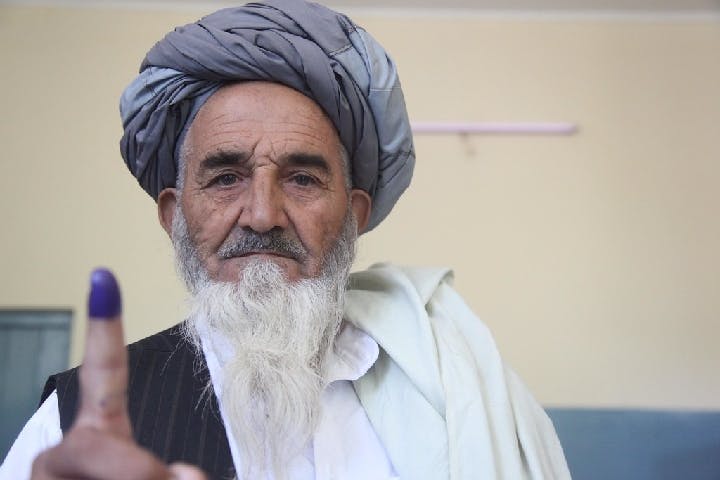Summer 2014
Afghanistan’s Illusion of Hope
– Michael Kugelman
Despite our best efforts at optimism, Afghanistan is in for a rough ride in the months ahead.
It’s tempting to be hopeful about Afghanistan these days.
The nation recently enjoyed an Election Day for the ages. About 60 percent of the voting population — roughly the same percentage as turned out in the last U.S. presidential election — ignored Taliban threats and ventured out to vote.
This defiance was perfectly predictable. Even as attacks were convulsing Kabul in the weeks before the election, Afghans were insisting the violence would galvanize them. The zeitgeist was captured in a political cartoon widely circulated on social media in the country; it depicted a burka-clad woman extending a purple ink-stained middle finger at a Taliban fighter.
Weeks later, the Election Day images still resonate: women waiting patiently in long lines, small children leading their blind fathers into voting stations, and, above all, happy people.
In a nation long afflicted by war and hardship, the smiles were a welcome and heartwarming sight. Yet there’s another side to this story.
Fair enough, hopeful voices might say. Things could have been much worse. And the upshot is that Afghanistan will soon have new leadership with a fresh mandate to focus on bringing some badly needed stability to the country.
True. Yet let’s be realistic: Afghanistan’s many problems — from corruption and ethnic tensions to militancy and deep poverty — remain firmly in place, and the sources of Afghanistan’s instability — many of them external to Afghanistan — won’t magically disappear, no matter how dogged the country’s new leaders. The Taliban’s sanctuaries in Pakistan’s North Waziristan tribal regions remain strong. And with international troops on their way out of Afghanistan, neighboring militants are on their way in.
Militants from the Punjab province are massing in Pakistan’s tribal areas in preparation for battle. The Pakistani Taliban, already an able accomplice to Afghan Taliban assaults, will likely deepen its cooperation. And not to be forgotten, in Afghanistan’s more tranquil northern and western regions, Central Asian jihadists are intensifying their activities.
To be sure, the capacities of Afghanistan’s military have strengthened significantly in recent years, and they deserve credit for averting numerous attacks on Election Day. Yet this is a force that continues to struggle to hold territory, conduct intelligence, and undertake air transport. And it still grapples with more basic problems like illiteracy, drug abuse, and desertions.
Even so, here’s where the narrative of hope reemerges: with a new leader in place, Afghanistan will finally sign a bilateral security agreement with Washington that allows for a residual international force in the country after 2014. Such a force will ease the Afghans’ burden, and make a major contribution to stabilization.
But let’s not get carried away.
Yes, a residual force would provide invaluable training and assistance to Afghan soldiers, and, more importantly, it would give a psychological boost to Afghan security forces prone to demoralization and uncertain about the international community’s long-term commitment. But a post-2014 international presence is no silver bullet for Afghanistan’s instability; it would be a modest non-combat force with no ability (or mandate) to defeat an insurgency that a much larger combat force was unable to defeat during 13 long years of fighting.
We can hope that Afghanistan’s new leadership will take immediate, emphatic steps to tackle the country’s greatest challenges: the troubled economy and deeply ingrained corruption. Both are exploited by the Taliban recruiters who court poor Afghans with promises of a paycheck while depicting themselves as a clean, just alternative to the government.
For Kabul, tackling these issues would make more sense as a way to rein in the insurgency than would seeking peace talks; with international troops leaving Afghanistan, the Taliban has little incentive to step off the battlefield.
So will Afghanistan’s next government be up for such tasks?
Why not? The optimists might insist. The new administration couldn’t possibly be any worse than its predecessor. Afghanistan’s next president, whether he is Abdullah Abdullah or Ashraf Ghani, will be a globally respected statesman with strong anti-Taliban credentials. True enough, but we’d be wise to consider how Afghanistan got to this point.
Years ago, a new Afghan president took power. He had been a prominent member of the anti-Taliban Northern Alliance, and worked closely with U.S. special forces when international troops entered Afghanistan in October 2001. The U.S. president called him a hero. Three former American presidents attended his inauguration. He wowed audiences and interlocutors with his charm, impeccable manners, and fluent English. He could seemingly do no wrong.
His name was Hamid Karzai.
At the end of the day, it’s fine to be hopeful about Afghanistan’s future. But we also need to be realistic.
—
Michael Kugelman is the Wilson Center’s senior program associate for South Asia. Follow him on Twitter @michaelkugelman or reach him at michael.kugelman@wilsoncenter.org
Cover photo courtesy of UNDP
